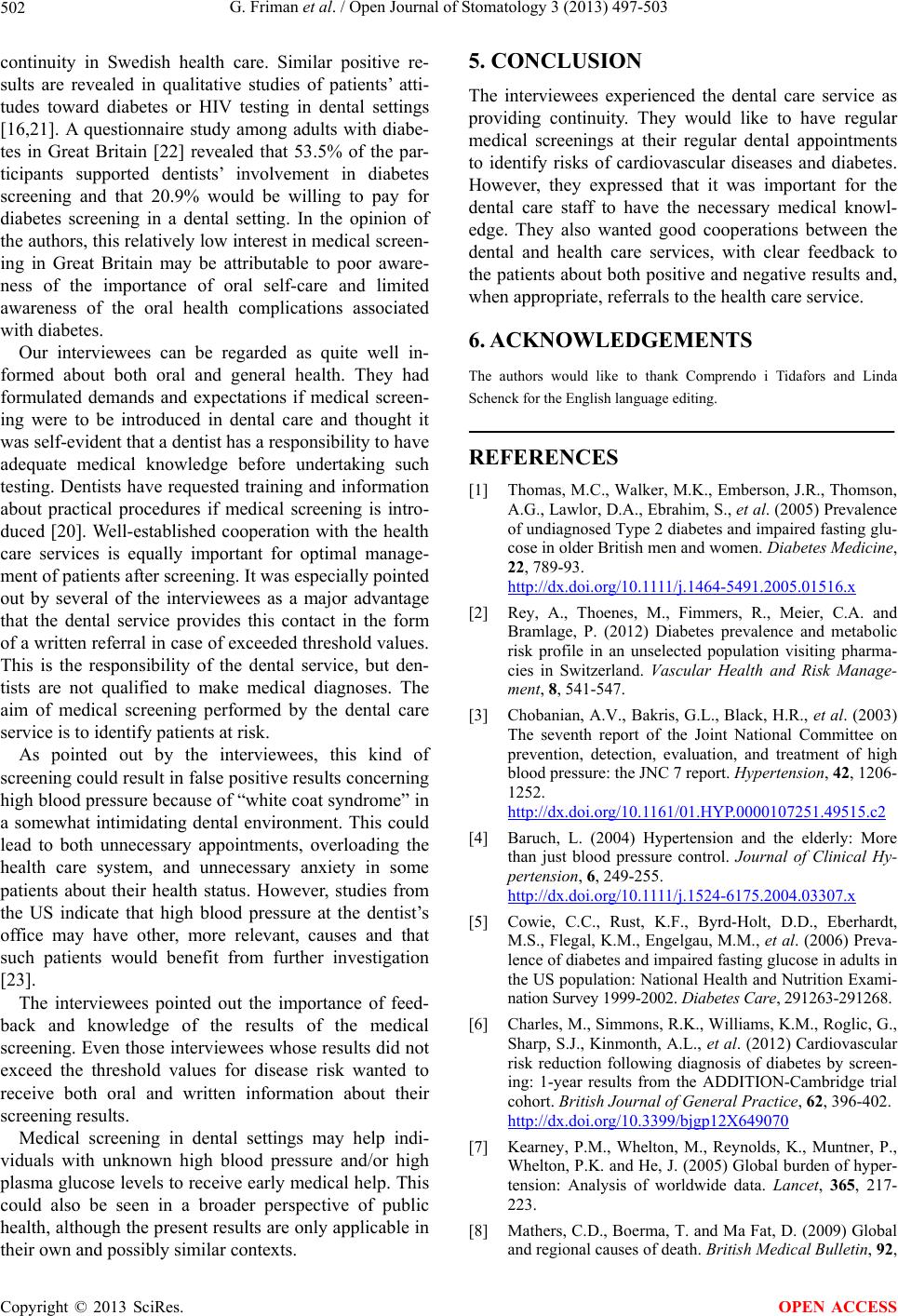
G. Friman et al. / Open Journal of Stomatology 3 (2013) 497-503
502
continuity in Swedish health care. Similar positive re-
sults are revealed in qualitative studies of patients’ atti-
tudes toward diabetes or HIV testing in dental settings
[16,21]. A questionnaire study among adults with diabe-
tes in Great Britain [22] revealed that 53.5% of the par-
ticipants supported dentists’ involvement in diabetes
screening and that 20.9% would be willing to pay for
diabetes screening in a dental setting. In the opinion of
the authors, this relatively low interest in medical screen-
ing in Great Britain may be attributable to poor aware-
ness of the importance of oral self-care and limited
awareness of the oral health complications associated
with diabetes.
Our interviewees can be regarded as quite well in-
formed about both oral and general health. They had
formulated demands and expectations if medical screen-
ing were to be introduced in dental care and thought it
was self-evident that a dentist has a responsibility to have
adequate medical knowledge before undertaking such
testing. Dentists have requested training and information
about practical procedures if medical screening is intro-
duced [20]. Well-established cooperation with the health
care services is equally important for optimal manage-
ment of patients after screening. It was especially pointed
out by several of the interviewees as a major advantage
that the dental service provides this contact in the form
of a written referral in case of exceeded threshold values.
This is the responsibility of the dental service, but den-
tists are not qualified to make medical diagnoses. The
aim of medical screening performed by the dental care
service is to identify patients at risk.
As pointed out by the interviewees, this kind of
screening could result in false positive results concerning
high blood pressure because of “white coat syndrome” in
a somewhat intimidating dental environment. This could
lead to both unnecessary appointments, overloading the
health care system, and unnecessary anxiety in some
patients about their health status. However, studies from
the US indicate that high blood pressure at the dentist’s
office may have other, more relevant, causes and that
such patients would benefit from further investigation
[23].
The interviewees pointed out the importance of feed-
back and knowledge of the results of the medical
screening. Even those in terviewees whose results did not
exceed the threshold values for disease risk wanted to
receive both oral and written information about their
scr eening results.
Medical screening in dental settings may help indi-
viduals with unknown high blood pressure and/or high
plasma glucose levels to receive early medical help. This
could also be seen in a broader perspective of public
health, although th e present results are only app licable in
their own and possibly similar contexts.
5. CONCLUSION
The interviewees experienced the dental care service as
providing continuity. They would like to have regular
medical screenings at their regular dental appointments
to identify risks of cardiovascular diseases and diabetes.
However, they expressed that it was important for the
dental care staff to have the necessary medical knowl-
edge. They also wanted good cooperations between the
dental and health care services, with clear feedback to
the patients abou t both positive and neg ative results and,
when appropriate, referrals to the health care service.
6. ACKNOWLEDGEMENTS
The authors would like to thank Comprendo i Tidafors and Linda
Schenck for the English language editing.
REFERENCES
[1] Thomas, M.C., Walker, M.K., Emberson, J.R., Thomson,
A.G., Lawlor, D.A., Ebrahim, S., et al. (2005) Prevalence
of undiagnosed Type 2 diabetes and impaired fasting glu-
cose in older British men and women. Diabetes Medicine,
22, 789-93.
http://dx.doi.org/10.1111/j.1464-5491.2005.01516.x
[2] Rey, A., Thoenes, M., Fimmers, R., Meier, C.A. and
Bramlage, P. (2012) Diabetes prevalence and metabolic
risk profile in an unselected population visiting pharma-
cies in Switzerland. Vascular Health and Risk Manage-
ment, 8, 541-547.
[3] Chobanian, A.V., Bakris, G.L., Black, H.R., et al. (2003)
The seventh report of the Joint National Committee on
prevention, detection, evaluation, and treatment of high
blood pressure: the JNC 7 report. Hypertension, 42, 1206-
1252.
http://dx.doi.org/10.1161/01.HYP.0000107251.49515.c2
[4] Baruch, L. (2004) Hypertension and the elderly: More
than just blood pressure control. Journal of Clinical Hy-
pertension, 6, 249-255.
http://dx.doi.org/10.1111/j.1524-6175.2004.03307.x
[5] Cowie, C.C., Rust, K.F., Byrd-Holt, D.D., Eberhardt,
M.S., Flegal, K.M., Engelgau, M.M., et al. (2006) Preva-
lence of diabetes and impaired fasting glucose in adults in
the US population: National Health and Nutrition Exami-
nation Survey 1999-2002. Diabetes Care, 291263-291268.
[6] Charles, M., Simmons, R.K., Williams, K.M., Roglic, G.,
Sharp, S.J., Kinmonth, A.L., et al. (2012) Cardiovascular
risk reduction following diagnosis of diabetes by screen-
ing: 1-year results from the ADDITION-Cambridge trial
cohort. British Journal of General Practice, 62, 396-402.
http://dx.doi.org/10.3399/bjgp12X649070
[7] Kearney, P.M., Whelton, M., Reynolds, K., Muntner, P.,
Whelton, P.K. and He, J. (2005) Global burden of hyper-
tension: Analysis of worldwide data. Lancet, 365, 217-
223.
[8] Mathers, C.D., Boerma, T. and Ma Fat, D. (2009) Global
and regional causes of death. British Medical Bulletin, 92,
Copyright © 2013 SciRes. OPEN ACCESS